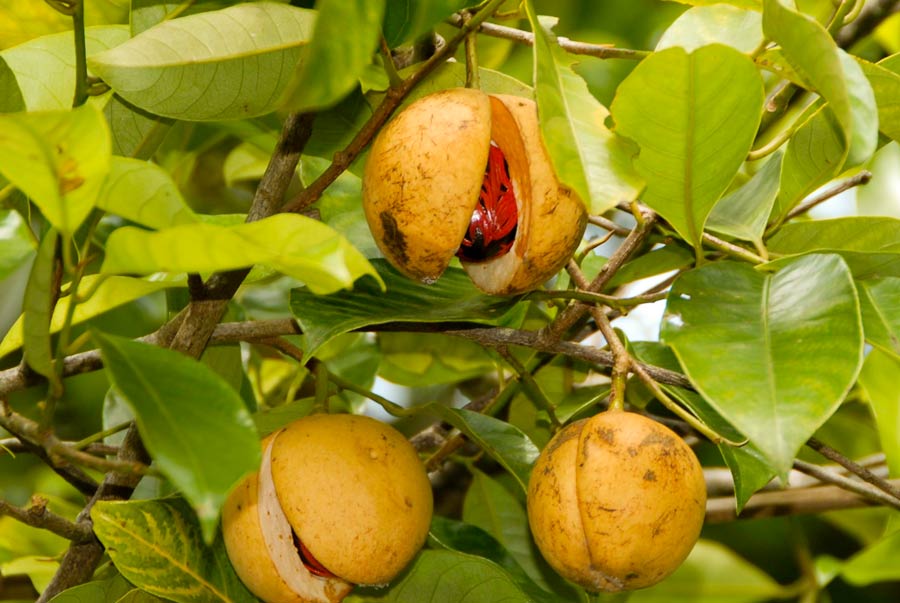Fragrant, rich nutmeg has been one of the most highly prized spices known since antiquity, because of its aromatic, aphrodisiac, and curative properties. Nutmegs are evergreen trees, native to the rain forest Indonesian Moluccas Island (also known as the Spice Islands). This amazing spice is a small package with several big benefits. While most of us think "baking and cooking" when we think of nutmeg, its benefits go way beyond that role. For instance, here are just a few of the many ways nutmeg is used for prevention and healing:
- Nutmeg has strong antibacterial properties and is effective in killing a number of cavity-causing bacteria in the mouth.
- Like cloves, nutmeg contains eugenol, a compound that strengthens the heart.
- Myristicin, an essential oil found in nutmeg, inhibits an enzyme in the brain that contributes to Alzheimer's disease and is used to improve memory.
- It is used in small dosages to reduce flatulence (excessive stomach or intestinal gas), aid digestion, and improve appetite.
- Nutmeg helps combat asthma and relaxes muscles.
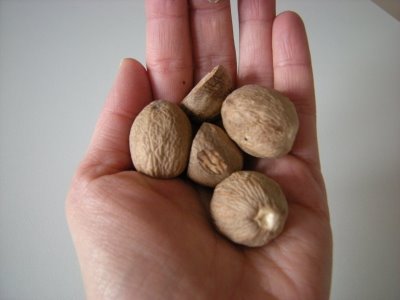
The best way to select nutmeg? The flavor degrades quickly, so it's better to buy it whole and in just the amount you'd use in a month. The best quality nutmegs are large and nicely rounded, and weigh around 7-8 g. Lesser grades weigh around 3g. To test for freshness (the best quality), insert a needle into the seed; if a tiny drop of oil seeps out, the nut is good.
Ground nutmeg is what's typically found on the grocery shelf. Check the expiration date before purchase, and use what you buy quickly; it deteriorates over time as it comes in contact with air and other aromas in the kitchen. Smelling your container of nutmeg is a simple way to know if it's still fresh and flavorful.
The best way to cook or bake with nutmeg? This isn't an easy spice to experiment with because it can easily overpower a recipe. So start with miniscule amounts if adding it to a recipe that doesn't call for it. But it is really worth the effort to learn how to use it because of the extra depth of flavor and punch it can give a dish.
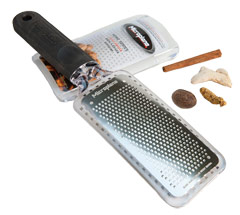
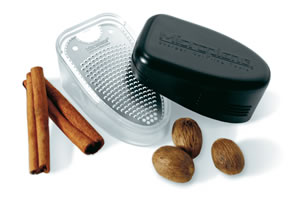
Freshly ground nutmeg provides the best flavor and you can buy a nutmeg grater (also known as a microplane) for this purpose—one with the finest blade is preferable. (I use mine for grating fresh cinnamon as well.) And it's best to use only small amounts in any recipe (1/4 to 1/8 teaspoon is the common amount shown); otherwise it can overpower a dish. Finally, add nutmeg early in the cooking process; this helps distribute the spice more evenly into the dish.
The best way to store nutmeg? Store ground and whole nutmeg away from sunlight in airtight containers. Avoid storing over the stove, sink, near a window, or near a source of heat or moisture as heat can cause the spice to stale quickly. Even though it's dry, it is heat sensitive and exposure to steam can increase the risk of bacterial or fungal contamination. If stored in a freezer and repeatedly removed for use, condensation will form, which will accelerate loss of flavor and aroma. Ground nutmeg keeps best in the dark. If purchasing it in a clear bottle, transfer it to a brown glass jar or opaque container.
Bottom line? Ground nutmeg should have a pungent, spicy scent and should be a light fluffy powder, not sticky, clumpy, or odorless.
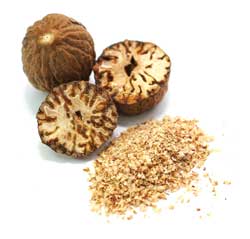
Best culinary companions? Nutmeg works well in:
- Sweet preparations such as pies, puddings, custards, cookies, cakes, pastries, sweet sauces, stewed fruits and raisins, breakfast cereals, juice, ice-cream, and jams.
- Savory dishes such as soufflés, cheese sauces, soups, gravies, pickles. It works well when combined with tomatoes, peas, black beans, cabbage, spinach, broccoli, onions, eggplant, cauliflower, French green beans, carrots, potatoes, and pumpkin. It also combines well with egg, chicken, meat products, pasta, and rice.
- Beverage toppings like eggnog, cappuccino foam, tea froth, milkshake, black coffee, and punches.
If wanting to use whole rather than purchased ground nutmeg, conversion is one whole nutmeg grated = 2 - 3 teaspoons ground nutmeg.
To conclude: If you are intrigued with this spice and want to use it more, consider creating a "Nutmeg" chapter in your Cook'n 11. This is where I've captured nutmeg facts and details on how to use and store it, resource information on the best places to buy whole nutmeg, and the recipes I've tweaked to include it. I know I sound like a commercial here, but honestly, Cook'n 11 does such a brilliant job of organizing all cooking and baking!
- www.amazon.com
- www.partydesignersecrets.blogspot.com
- www.thespicehouse.com
- www.cooksnook.com
- www.completewellbeing.com

Alice Osborne
Weekly Newsletter Contributer since 2006

